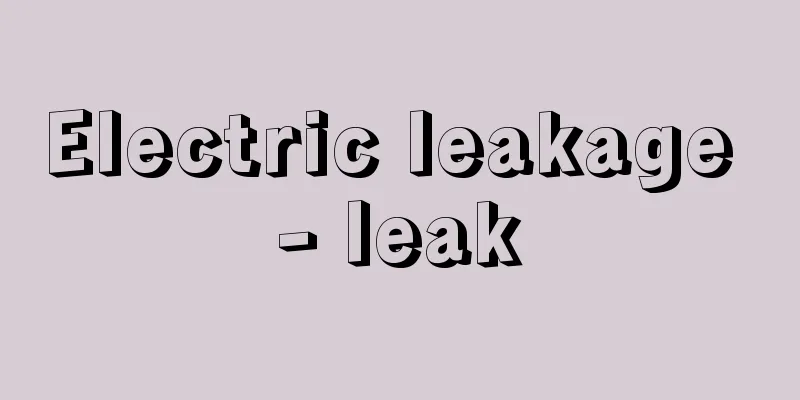Electric leakage - leak

|
This refers to a state in which leakage currents occur in electrical circuits, including equipment, that are greater than the necessary value. Leakage current is a current that flows outside of the electrical circuit, and flows inside and on the surface of the insulator of the electrical circuit, as well as through space between the lines or between the lines and the ground. Leakage current is checked by measuring the insulation resistance with a megger. For electrical circuits with a voltage to ground of 150 volts or less, the insulation resistance must be at least 0.1 megaohms, for circuits with a voltage to ground of 150 volts or less, 0.2 megaohms for circuits with a voltage above 150 volts, and 0.4 megaohms for circuits with a voltage above 300 volts (Technical Standards for Electrical Equipment). The main causes of leakage current are (1) deterioration of the insulation of the electrical circuit, (2) destruction damage caused by external forces, (3) intrusion of moisture, and (4) damage to equipment. If leakage current continues to flow in the area where leakage current occurs, the insulation condition of that area will deteriorate at an accelerated rate, so care must be taken. Leakage current in indoor wiring will flow into the building, causing electrical fires. Electric leakage from electrical equipment can have serious consequences, such as causing electric shock to anyone who touches it and resulting in death or injury. In order to prevent accidents caused by electrical leakage, methods are used to automatically detect leakage current and cut off the circuit. High-voltage substation equipment is equipped with earth fault relays that detect zero-phase current caused by electrical leakage and automatically cut off the circuit. Low-voltage circuits also use leakage current alarms or leakage current breakers. The Electricity Business Act and Fire Service Act stipulate standards for the installation of these devices. [Koshino Kazuji and Ichikawa Noriaki] [Reference item] | |Source: Shogakukan Encyclopedia Nipponica About Encyclopedia Nipponica Information | Legend |
|
機器を含めた電気回路において必然的数値以上の漏洩(ろうえい)電流が発生する状態をいう。漏洩電流とは電路以外に流れる電流であって、電路の絶縁体の内部および表面ならびに空間を通じて線間または大地との間に流れる電流である。漏電を調べる方法はメガーにより絶縁抵抗を測定することで行われる。対地電圧150ボルト以下の電路では絶縁抵抗値は0.1メガオーム以上、150ボルト超過では0.2メガオーム、300ボルト超過では0.4メガオーム以上の数値が分岐回路ごとになければならない(電気設備技術基準)。漏電の原因は、(1)電路の絶縁物の絶縁劣化、(2)外力による破壊損傷、(3)湿気の浸入、(4)機器の破損がおもなものとしてあげられる。漏電箇所は漏洩電流が流れ続けると加速的にその部分の絶縁状態が悪くなるので注意を要する。屋内配線の漏電は建造物に漏洩電流が流れ、電気火災の原因となる。電気機器の漏電は、これに触れる人が感電して死傷事故を起こすなどの重大結果となることがある。 漏電による事故を未然に防止するには、自動的に漏洩電流を検知して回路を遮断する方法がとられている。高圧受変電設備では地絡継電器(地絡リレー)が設けられ、漏電地絡による零相電流を検出し、自動的に電路を遮断する。また、低圧電路では漏電警報器か漏電遮断器が採用される。電気事業法および消防法関係法令ではこれらの機器の設置の基準を定めている。 [越野一二・市川紀充] [参照項目] | |出典 小学館 日本大百科全書(ニッポニカ)日本大百科全書(ニッポニカ)について 情報 | 凡例 |
Recommend
Inoue Enryo
A Buddhist philosopher and educator from the Meij...
"A Small Excerpt from the Farming Course"
…He also criticized the trend of “respecting the ...
Marine Research Institute
A research institute for the purpose of oceanogra...
Synchronicity
…CG Jung believed that a transcendental dimension...
Ordo Fratrum Carmelitarum Discalceatorum
...In 52, Johannes Soret founded the Female Carme...
Cyperus rotundus; coco grass
A perennial plant of the Cyperaceae family, also c...
Laminaria longissima (English spelling) Laminarialongissima
…[Yoshiharu Iijima]. … *Some of the terminology t...
"General Linguistics Lectures"
… [Saussure and Structural Linguistics] F. de Sau...
Sea Dragon King - Kairyuou
A dragon king who lives in the sea. A dragon god. ...
Lampetra mitsukurii (English spelling) Lampetra mitsukurii
…[Toru Taniuchi]. … *Some of the terminology that...
CFDT - Computational Fault Tolerance
(France) Confédération Française Démocratique des ...
Yokohama [city] - Yokohama
A city in the eastern part of Kanagawa Prefecture....
Toamasina
Toamasina is a port city in the eastern part of t...
TERCOM
However, with the advancement of technology, the ...
Acute gastric ulcer - moxibustion ulcer
…The most common sites of development are the les...









